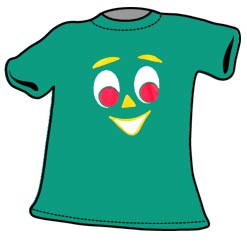
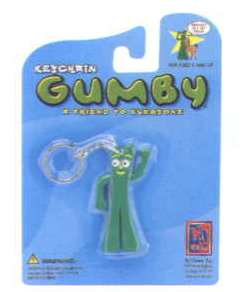
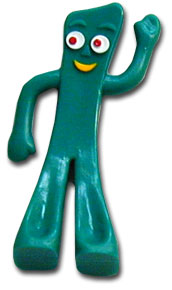
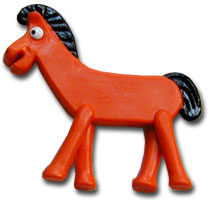
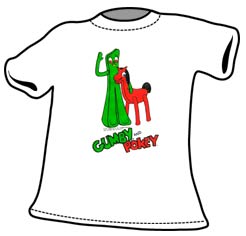
Are you a Gumby and Pokey fan? Click here for Gumby merchandise
Gumby and Pokey Interview with Creators
Good evening and welcome to Brainstorms. I'm your host, Dr. Keith Harary, Editor at Large of Omni. Our guests tonight will be Art and Gloria Clokey, creators of the world famous children's character, Gumby. For clarity, as always, we'll identify ourselves by our initials: KH for Keith Harary, AC for Art Clokey, and GC for Gloria Clokey. Welcome to Brainstorms, Art and Gloria Clokey!
AC and GC: Well, this is an exciting event. It's our first time on the Internet. This is really interesting. We've never seen this before and we're excited about it.
KH: Speaking of exciting new experiences, Gumby certainly was an innovation when he and his pals first appeared on the scene. They have become real cultural icons over the past 42 years. One of the things I've noticed is that Gumby and his pals seem to solve most problems without violence. This seems very different from most children's television.
AC: Let's define violence more precisely as violent action against other
characters which you won't find in the Gumby series or movie. In the movie, he cuts off
the arm, for instance, of a robot, but not another character.
The reason that there isn't any violence against people or charcters in Gumby is probably
because of my background -- I studied to become an Episcopal priest or minister at one
time, and was brought up in a musician's home in a very non-violent manner.
KH: That brings up the question of Gumby's origins. How did you come to first create Gumby, Art? I hope you'll also help us solve the mystery of the bump on Gumby's head!
AC: The bump aside, Gumby's real beginnings were, as I look back, amazing.
It started with me making Budweiser commercials -- producing and writing Budweiser
commercials. While making the commercials, in my free time I made an art film of animated
clay shapes, forms, to jazz music. Today it would be called a music video -- 3-1/2 minutes
long -- called Gumbasia. As I had seen Disney's Fantasia, and there are lie parts of
Disney's Fantasia -- only not clay, they're drawings.
Sometime later, I was teaching at a private school called Harvard School. It was a
military academy at the time where producers and directors' sons went -- Frank Capra's son
was there, Daryl Zanuck's son was there. I was tutoring in English the son of another
producer, named Samuel Engel, the son of a rabbi. Sam appreciated what I was doing for his
son Charles. He invited me to the 20th Century Fox studio, where he was producing a movie
with Sophia Loren. He wanted me to bring along my Gumbasia film. After showing it to him,
he got up, paced back and forth in front of the screen, and said, "Art, that's the
most exciting film I've ever seen in my life." He said, "Art, we've got to go
into partnership." Wow! He said, "I want to improve the quality of television
for children." He said, "Can you make little figures out of this clay,"
because in Gumbasia there were no figures -- just shapes and forms. He asked me if I could
tell stories with them. I said yes and he said, "If you can, I will finance a pilot
film for a series. You think up the characters." I went back home, worked with the
clay, experimented with figures and came up with a Gumby shape. In partnership with Sam
Engel, I produced a story and fashioned this Gumby shaped character, took it and showed it
to NBC -- Tom Sarnoff. He immediately signed us up and in six months Gumby had his own
show on Saturday morning. Then, Sam handed it all over to me. He wasn't interested in
making money from Gumby; he was interested in getting something of quality and value on
the TV screen for children. He was a very philanthropic person -- probably because he was
the son of a rabbi.
Because of this, we call Sam Engel the godfather of Gumby. As for the bump, it's on
Gumby's left side, and it was established as a distinguishing mark from just a plain old
slab of clay to give Gumby a character trademark. This was derived from my experience on
my grandfather's farm where a large photograph of my father was on the wall in the living
room of the farm house. It was a high school graduation photo and he had a large cowlick
on his head -- that is a big curl of hair -- a pile of hair -- it was on his right side,
but I put it on Gumby's left side. It intrigued me as a boy of four of five years of age.
I asked my grandmother, "Why does Daddy have a bump?" She explained that it was
not a bump, but an unusually large cowlick -- that is an unusually prominent curl of hair.
KH: Gloria, where did you come into the picture? I understand that your art direction has been a vital part of the Gumby series for many years.
GC: I came into the picture about 26 years ago when I first met Arthur and actually first
met Gumby. I had not been a fan of the Gumby show. My children from my first marriage had
watched Gumby, but he was new to me. As our relationship grew, I became more involved with
Gumby and eventually became very involved with the new Gumby TV series and the feature
length movie.
KH: One of the compelling aspects of Gumby for me are all of the unusual characters. You not only have humanoid characters, but you also have a horse, a dinosaur, a flying mermaid, blockheads, and others. Do these characters symbolize anything in particular?
AC: The flying mermaid and the yellow dinosaur -- Goo and Prickle --
originated from a lecture that I heard at San Jose State College where Alan Watts, the
philosopher, told the audience there were two kinds of people in the world -- the prickly
and the gooey -- the rigid, critical and the easygoing and mellow. Goo, of course. I
decided that would be a good idea -- to make two characters to represent the two types of
people.
The Blockheads derived from my interest in playing blocks as a child. I used blocks a lot.
And sometimes I was called a blockhead.
Pokey entered in the third episode, I believe, where Gumby rescued him from being run over
by a train. Pokey is really a combination between a pet dog and a pet pony, or horse. My
grandfather, where I spent a lot of time every summer, had a horse and a dog, and I
combined the two into Pokey.
GC: When I became involved with the Gumby series and the movie, it was very exciting for me and, due to my artistic background, I fell into the role of being an art director quite naturally. It was so much fun to create all the miniature props with the other artists who were working under me, and sets. And the sets were fascinating and so satisfying to my creative nature.
GC: In producing the movie, we made 65 different sets, which is unheard of in a feature length film. It was so rich, and is today a unique movie, that children want to watch over and over again because of such a variety. Parents plead with us, "When are you going to make the second movie?" so they can have something else on their television set instead of the Gumby movie which sometimes children watch three or four times in a single day. We hope that we can do - in fact, we do have a script for a second movie, and are working on that becoming a reality soon.
KH: Speaking of the sets, I have never encountered a reality quite like the world of Gumby and his pals anywhere but in your series. They walk through books and enter various realms, and the whole scene is strewn with giant toys and all sorts of Surrealistic, dreamlike, images. You might say the art appears to be geared more toward adults or at least to including adults with the children. Where is Gumby's world anyway?
AC: The world of Gumby -- the way you were describing it -- could be in cartoons as well -- going in and out of books and doing all sorts of strange contortions -- but they're not real. Gumby is real, the sets are real, everything is real. They're not drawings and they're not electronic images generated in a computer, which is another form of abstraction, like drawing.
KH: I understand that Gumby's world is real, unlike cartoons or computer generated electronic images. But, beyond that, Gumby's reality is unique in its physical properties. For example, the characters pass from one dimension to another and can even change shape. That seems very dreamlike. Was this deliberate?
AC: It's only interesting because it's real. They do that sort of thing in cartoons and by computer. It is not deliberate that Gumby's world is dreamlike; it comes out of my subconscious. Sometimes they're prophetic and sometimes they reflect what's happening in the real world. Symbolically. Gumby is meant for children -- of all ages.
GC: I'd like to talk about the medium -- clay. Another thing about Gumby and the Gumby stories is that Gumby is clay and the main characters are clay and children can relate to clay because they play with clay and shape things and many children like to make clay Gumbys. And also clay is so elastic that it can go into all different shapes. Gumby can turn into a ball, or a rope of clay. This is unique too and also very intriguing to children. And also clay has a sensuous quality about it -- that people can feel tactilly related to.
AC: Humanity has been making clay figures for 50,000 years at least, so it's deeply engrained in the collective unconscious, I guess.
GC: Also, I would like to say about clay that the animators, when they're working with clay figures, they put some of themselves into it and so you will sometimes see thumbprint or something but they also put a lot of their own feelings about it into it, and therefore Gumby seems very human, and real.
AC: One of our former animator told me on the phone recently that animating on a computer is like animating with chopsticks. With Gumby, it's hands-on.
KH: Can I ask you both about your favorite Gumby episodes?
GC: My favorite episode was called "Hatching Out." I loved the story but I also loved the challenge of the story because there was a large dinosaur and, technically, the challenge was in scale and making it all work. This probably was one of the scariest episodes because Gumby gets eaten by the dinosaur and then turns up in a dinosaur egg where he eventually hatches out.
AC: My favorite episode was called Rip Van Prickle. In Prickle's dream, Gumby is President. Gumby brings to the nation a non-polluting fuel.
KH: Unfortunately, we're out of time for tonight's show. But we could easily go on all night. I hope you can both come back another time.
AC and GC: We'd be delighted!
KH: One last question before we go -- who does the unique voices that we hear in the Gumby show?
AC: Gloria does Goo, the Witty Witch, Tilly the Chicken, Granny, and others. I do Pokey, Prickle, Gumby's father, King Ott and other miscellaneous characters. Dallas McKennon does the voice of Gumby and other characters.
KH: Well, that's it for tonight's show. Thank you Art and Gloria Clokey for giving us some special insights into your beloved television characters. I'm Dr. Keith Harary, inviting our audience to join us again next week for another edition of Brainstorms. Good night and Happy New Year to all!





Are you a
Gumby and Pokey fan? Click here for Gumby merchandise